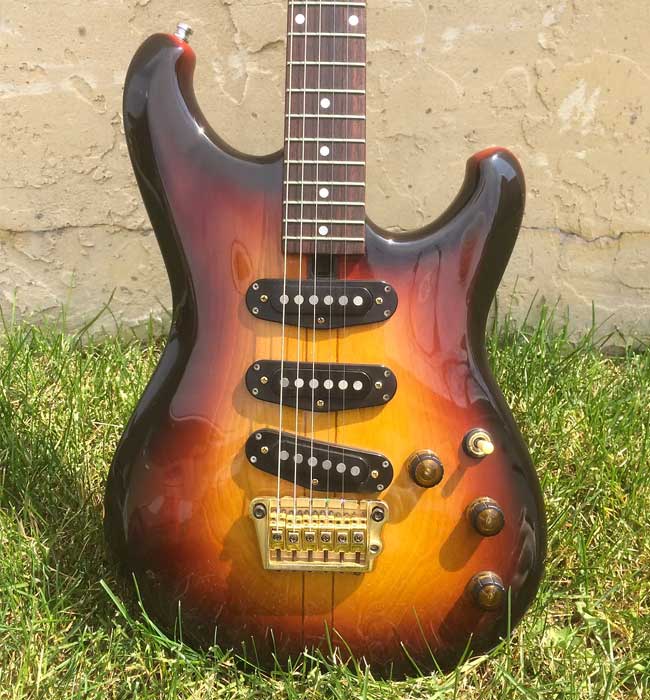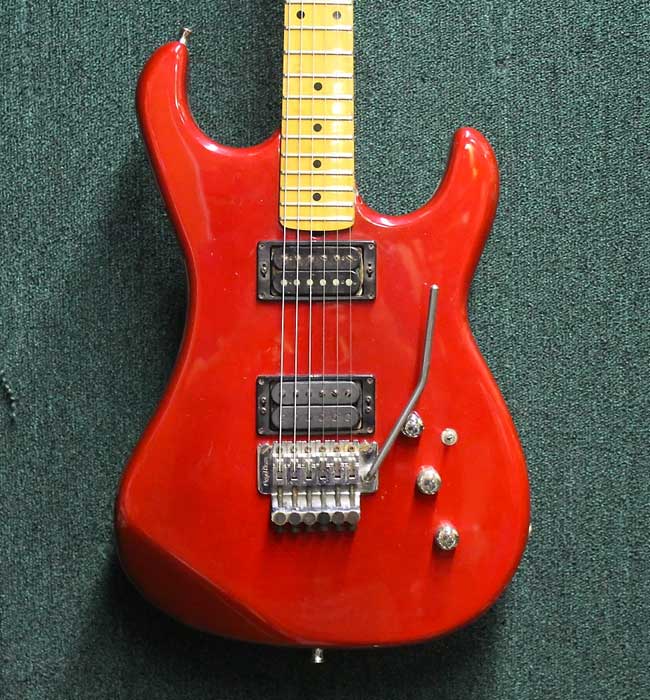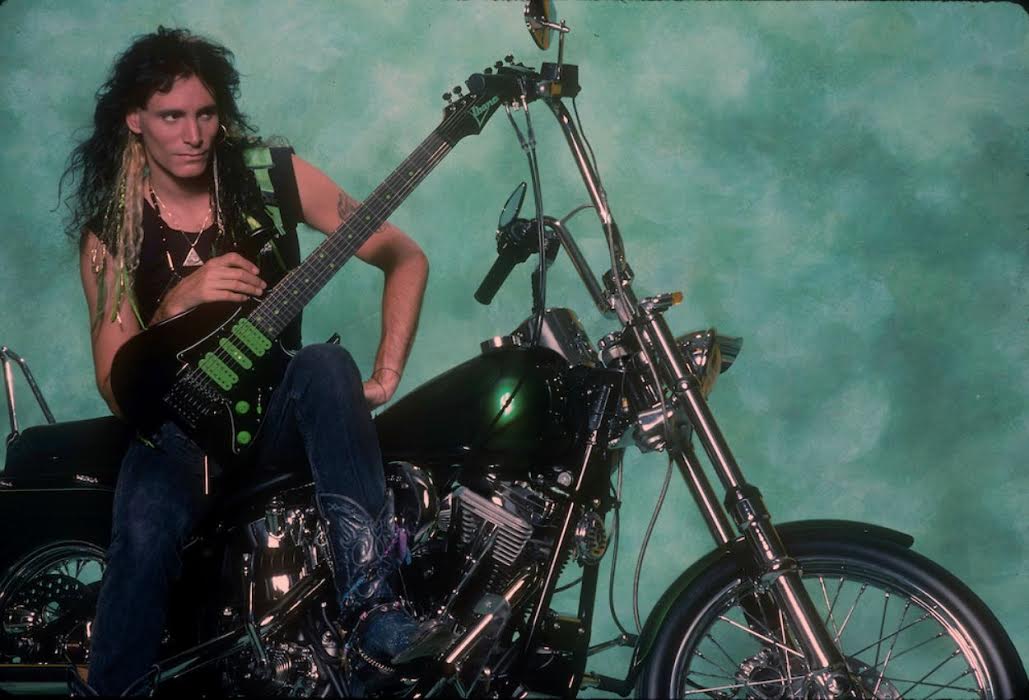There is perhaps no brand that has more of a connection to its heyday in terms of spirit and practice than Ibanez. With its recent reissues of the RG550 series and the unveiling of the brand new AZ series, Ibanez seems to be tipping its hat to not just its own history but the climate that created it: the era of Kramer dominance and the "Super Strat."
When it comes to '80s guitars and the '80s as a decade culturally, it has at times been an acquired taste, to say the least. In 2018, however, it is becoming apparent to guitar players around the world that the '80s were a time when a lot of amazing guitars were made. From Fujigen's roots as the heart of both Ibanez and Fender Japan to ESP's role in Kramer production, it was a decade of global collaboration.
It could be argued that this era saved the guitar industry as we know it today thanks to the vast innovations and improvements in design, production methods, and quality control. With that in mind, we are taking a look at Ibanez's most recent offerings and their roots in the '80s—the decade of shredders.
Ibanez AZ Series: A Modern Tribute to the Roadstar II and Super Strats
One of the big highlights of NAMM and Ibanez's 2018 display was the debut of the AZ series. In a lot of ways, it is perhaps one of the most historically informed and interesting series to come from Ibanez in a long time. The body and headstock shape hearkens back to '82/'83 Ibanez models, but reworked for the modern player. Specifically, the AZs automatically bring two early '80s guitars to mind: the Ibanez Roadstar II and the Kramer Pacer.


It is, to my eyes and hands, essentially an updated, modern take on the non-locking versions of those guitars, with deeper cutaways and a modern-futuristic contoured back and heel. To fully understand this series, let's revisit the history and historical influences behind it.
Ibanez Meets the Super Strat
Coming out of the '70s into the '80s, Ibanez was in the middle of what was essentially a branding crisis. Throughout the previous decade, Ibanez was largely known as a copycat company with its Japanese-made Fender and Gibson knockoffs, until legal pressure brought that era to an end. Even though, by '83, the company was making original models, Ibanez did not have a distinctive identity or a hallmark guitar.
Eddie Van Halen, Kramer, and the "Super Strat" were taking over the guitar world by brute force—and Ibanez was at risk of being left behind as just another lawsuit brand of the past. Guitarists and guitar companies all over were experimenting with locking tremolos, more aggressive pickups, and new pickup combinations to meet the needs of post-Van Halen rock music and heavy metal. At the same time, the most notable original model for Ibanez after the infamous 1976 Gibson lawsuit was the George Benson Signature model—a jazz guitar. Branding issues aside, sales were slowing into the early '80s.
By 1983, the Kramer Pacer and Baretta were revolutionizing the guitar industry. With their use of the new Floyd Rose locking tremolo system and their implementation of unconventional pickup combinations on high-quality Strat-style guitars, players were able to get new sounds and employ new techniques on stock Kramer guitars, instead of having to modify their Fenders. With Eddie Van Halen as their posterboy, Kramer was quickly gobbling up the electric guitar market and almost every legacy company within its wake.
To keep up with Kramer and the evolving needs of the modern guitarist, Ibanez knew they had to introduce models that would appeal to a certain kind of player—and to do so, they needed players to popularize the instrument.
Enter the Ibanez Roadstar II, aka the RS series. Introduced in '83, it was at its heart a vast series of stylish super Strats that ranged from budget-level bolt-on models to signature models with birdseye maple tops, all the way up to a near-boutique neck-through offering. Having evolved from the earlier Roadster series, the Strat-inspired Roadstar II came with vintage Fender-style neck shapes, a modern fingerboard radii, a number of pickup options (H, HS, HH, HSS, SSS) and choice of hardtail or tremolos (with options for traditional non-locking or locking trem systems).
Ibanez quickly got the new model into the hands of some of the premier guitar heroes of the day, including studio legend Steve Lukather, fusion icon Allan Holdsworth, Gary Moore— and, of course, the foremost '80s guitar hero, Marty McFly. Despite these notable players and in spite of the quality of the guitars—these were essentially sister guitars of Fender Japan via Fujigen, mind you—the Roadstar II didn't exactly set the guitar world on fire.
Even with its later debut of the beloved Edge Tremolo, the Roadstar II never was a leading instrument of the era in terms of popularity. Overwhelmed by Kramer's market dominance in 1986, sales had drastically slowed for Ibanez in the U.S. to dangerous levels.
In The Ibanez Electric Guitar Book, Hoshino USA CEO, Bill Reim told noted guitar writer (and Reverb contributor) Tony Bacon about Ibanez's U.S. sales and operations at the time: "We got to the point where we were shipping maybe only 50 or 60 guitars a month. … The morale was so crushed. But some of us started noticing a movement out there that we weren't involved in, a whole school of young new players that we should be working with."
That brings us to the guitar that just received its latest reissue—and the leading artist of Ibanez.
Ibanez RG550 2018 Reissue: The Crown Jewel
The respectable thing about Ibanez in their modern form is that they know what their longtime fans want. While other legacy companies have actively abandoned formal reissues and been accused of losing the plot in terms of design, Ibanez in 2018 is sticking with the things that won players over in the first place on its new models and reissues.
Case in point: the new RG550 reissues. If you've have played the company-defining originals or the fast-selling 2007 and 2013 reissues, this guitar will feel instantly familiar. Outside of the changes from a one-piece maple neck to five-piece maple/walnut necks (which have been present on every 550 reissue) and the updated V7 and V8 pickups that have been used since 2013, the guitars are remarkably similar to the 1987-'94 originals.
To get a better sense of why these guitars are so beloved to the history of the company and Ibanez fans around the world, let's take a trip back to where we left off.
Ibanez Takes Over/The Rise of Vai, the JEM, and the RG550
Going into 1987, USA and Japanese Hoshino executives decided that they needed to get real about Ibanez's brand identity and their new models. One of the unanimous conclusions that these executives had was that the brand needed a signature artist that personified the guitars they wanted to build in a way that Eddie Van Halen had for Kramer in previous years. The other immediate conclusion was that the player in this case had to be former Zappa protege and David Lee Roth guitarist, Steve Vai.
Immediately, Ibanez set out trying to woo Steve Vai in hopes of being able to finish a signature guitar by NAMM in June 1987. According to Steve himself at the time, Ibanez wasn't alone, but they were the quickest to act and the most responsive to his needs.

Per The Ibanez Electric Guitar Book, Kramer and Yamaha were trying to work on a signature guitar for him as well, but in Kramer's case they ultimately were more focused on making Steve feel like a rockstar in public instead of actually making him a fully customized guitar in a timely manner.
On the other hand, he received back his first custom JEM prototype from Ibanez within three weeks and, according to Steve, it was "better than what I wanted." That says a lot about the prototypes, as Steve had a huge hand in designing the JEM and was responsible for many of its key innovations—including the "Monkey Grip" handle and HSH pickup combination.
With the addition of the disappearing pyramid inlays, and the now famous "Lion's Claw" bridge routing, the JEM was ready for its debut. NAMM '87 came around and the Ibanez display was shrouded in mystery. By the time of the JEM's unveiling ceremony, a huge crowd of guitar enthusiasts and industry professionals had surrounded the booth including the Kramer team.
Rich Lasner remembers in Bacon's book, "You could see all the guys from Kramer … who had pretty much been kicking our ass for the last couple of years with Van Halen. They were standing there with their arms folded, wondering what on earth's going on. We dropped the black cloth, and there's a giant poster of Steve Vai playing the JEM. Everyone applauds. I look over at the Kramer guys. Their jaws are on the floor, and they're walking away. That to me was a moment of, like, Wow! We actually may have done this. You know? We did something here."
Upon its release, the JEM was a smash hit for Ibanez—helping establish the company and Vai at the forefront of the guitar industry. This all coincided in the Summer '87 with the new RG series and the RG550, which was in a lot of ways co-designed by Steve Vai. Initially, the RG series (stands for Roadstar Guitar—see what they did there?) was a mixture of older RS-series Roadstar style bodies with new point-style Ibanez headstock and thin necks.
The crown jewel of this series was the RG550. Over the next couple of years, the old RS/Roadstar bodies style would be phased out. They were briefly replaced by a Satriani signature-like redesign of the body—predating the Satriani models—before the Roadstar name formally went the way of the dinosaur with Kramer by the end of the decade.
The RG550 in many ways is a JEM stripped of many of the signature JEM-isms. Everything is essentially the same except for the lack of a "Monkey Grip" handle, Lion's claw, and brightly colored pickups. The vibrant colorful finishes and renowned shredability of the JEM are largely still there, of course.
The RG series, specifically the RG550, would go on to be a massive success, arguably even bigger than the guitar it was based on. It has spawned off into innumerable re-interpretations and continues to be one of the most, if not the most, beloved series in the Ibanez line. Attesting to the success, Steve Vai noted that he once read statistics stating that the RG was the second best-selling guitar of the modern era, behind only the Fender Stratocaster. Not bad for a shredder guitar and a 'lawsuit' brand.
About the Author: Casey Hopkins is a Brooklyn-based writer and songwriter/guitarist for The Advertisers. Aside from writing for Reverb and pursuing music, Casey is a recovering guitar salesman, assembler, and history major. Follow @CaseyHopkinsGuitar on Instagram to keep up with him.



